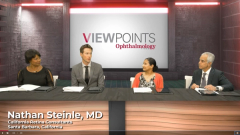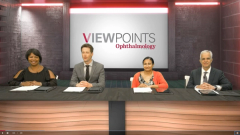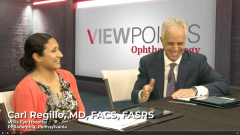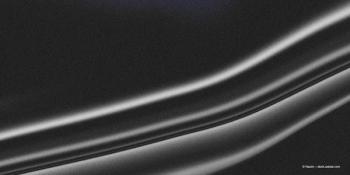
Phase 3 Studies of Faricimab in Neovascular AMD
Drs Nathan Steinle, Adrienne Scott, and Carl Regillo comment on the phase 3 trial outcomes of faricimab in neovascular AMD.
Episodes in this series

Nathan Steinle, MD: In early 2022 in the United States, faricima became available and at least first in my knowledge it came out for both DME [diabetic macular edema] and wet AMD [age-related macular degeneration] at the same time. Dr Scott, can you talk to me a little bit about this molecule faricimab and why you might want to apply it to your patients?
Adrienne Scott, MD: Sure. So faricimab is groundbreaking in the fact that we’re looking at another mechanism for the angiogenesis pathway that is tied to the angiopoietin inhibition pathway. We know that corneal neovascularization and diabetic macular edema are multifactorial processes. There are very complex pathophysiologies, multiple pathways, and multiple molecules involved, so I think it’s quite unique and quite interesting that we’re looking at inhibiting the angiopoietin pathway as well as another mechanism of stabilizing the disease.
Nathan Steinle, MD: That’s great. Dr Regillo, I know you’ve presented on these topics before but talk to me a little bit about the phase 3 data for neovascular AMD, the TENAYA and LUCERNE studies.
Carl Regillo, MD, FACS, FASRS: It is true that this is a unique molecule in that it’s not just a VEGF-A blocker. It’s a dual mechanism blocking VEGF-A just like all our prior therapeutics that we’ve been using for years and blocking angiopoietin too. The potential upside to that is better durability, maybe better efficacy, and better drying which is tied into efficacy and durability. The phase 3 TENAYA and LUCERNE studies for faricimab, the phase 3 clinical program was a noninferiority study comparing faricimab head-to-head with aflibercept.
After a loading phase, the dosing of faricimab could be adjusted based on disease activity with treatment intervals of 8, 12, or 16 weeks. So variable dosing in an attempt to have some individualizing of the therapy in terms of treatment interval compared to a fixed every other month aflibercept. It met its primary end point in both studies independently, which was of course noninferiority in mean BCBA[best-corrected visual acuity] from baseline. So both drugs worked equally well, if you will, in terms of getting the visual gains that we come to expect with VEGF-A blockade, and same with the OCT [optical coherence tomography], anatomico comes very comparable. That was able to be achieved with extended dosing, at least dosing intervals that were 12 to 16 weeks in the majority of our patients. In fact, by the end of the 2-year study, almost 80%, or around 80%, of patients in the faricimab arm were being dosed either 12 or 16 weeks and about 60% were being dosed every 16 weeks, which is pretty impressive.
It was mentioned earlier that we typically in practice will do treatment extend and cap at 12 weeks, so this is telling us that we have the potential to extend with a treat to maybe 4 months with this drug. It gives us the impression that the drug lasts longer and with the DME studies, which we’ll get into, perhaps dry better and that’s also beneficial for our patients.
Transcript edited for clarity
Newsletter
Keep your retina practice on the forefront—subscribe for expert analysis and emerging trends in retinal disease management.



















































